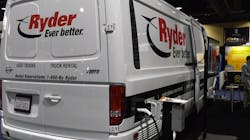ATLANTA — For the growing regional haul segment, the time is right for battery-electric trucks and is focusing its energy and resources on a three-year study to research how to grow their presence in regional fleets, the North American Council for Freight Efficiency (NACFE) announced at Technology & Maintenance Council 2020 event.
“Our research has shown us that regional haul is an important segment of the trucking industry and also one that makes sense for electrification, given its short-haul nature and return-to-base operation,” said Mike Roeth, NACFE executive director, who noted there are about 800,000 regional trucks in the United States
Endeavors such as the Regional Run on Less to set new mpg benchmarks and Medium-Duty Electric Truck: Total Cost of Ownership executive summary have led the 10-year-old non-profit to believe the time and conditions are right to switch the conversation from if BEV trucks takeover more regional routes to how?
“This regional haul group of trucks are ready for electric trucks now,” Roeth said.
Rob Reich, chief administrative officer at Schneider National and NACFE chairman, concurs.
“We're going to see more and more regional type operations,” Reich said. “Obviously, our drivers want to get home more often.”
He added as Schneider’s intermodal business expands, opportunities to electrify drayage trucks also exist.
Reich believes NACFE is the right organization to show how electric vehicles can impact regional haul trucking.
A lot of questions still need to be addressed, including if routes will need to be shortened do to BEVs’ typically shorter ranges, to increasing dwell time so the trucks can charge back up.
Reich said the NACFE initiative, which also includes EV workshops, will help answer "all those questions, that historically, we simply never had to think of."
“This electric truck isn't as easy as maybe we first thought,” Roeth said. “So, now as we dig into it, there are a lot of challenges.”
Some of those challenges include preparing the people and fortifying the grid.
“We got past some of these bigger chunks, and now we're thinking about where we get the technicians to do this and about brownouts.”
These are smaller questions, as Roeth asserted, “We still see it is going to happen and it should happen.”
There are four primary ways NACFE will facilitate the electric revolution for routes reached on a day with four new workstreams.
Identifying high potential regional trucking routes: NACFE is creating a matrix to identify which regions are the best places to focus resources. The group wants to focus on the most hospitable corridors to electric trucks so they can grow. Candidates should have a heavy freight traffic and be located within states and communities that are already pushing for zero emissions. Having local utilities pushing electricity, as well as warmer climates that are less harsh on battery life, also would improve an area’s standing.
Supporting implementation on first and next mover deployment: California has a litany of success stories, and Roeth hopes shining a light on these, and lesser known developments near Seattle, will catalyze more and more communities and fleets to buy in.
Scaling best practices in infrastructure deployment: “I think infrastructure is already starting to rear its rear its head as an issue,” Roeth said. “The last thing a Daimler or a Tesla Deliver wants to do is deliver a tracking and there’s no charging.”
To combat that, NACFE and partner Rocky Mountain Institute, which has a core competency in infrastructure, will work with electric utilities and wind and solar providers to find funding and get the needed equipment and installers to push electric trucks into the mainstream.“How long will subsidies help trucking charging infrastructure?” Roeth mused. “Longer than a lot of people think because there are so many benefits to these trucks that people are going to want to help spur them along with.”
Increasing confidence in value of electrification: Roeth admitted “electric trucks have a lot of benefits that are difficult to monetize,” so he has marked this as the start of a three-year period “to really dig in and bring that data to the marketplace around electric trucks.
As a start, NACFE has removed the paywall for its reports. He reported hundreds of downloads of that medium-duty truck report since the beginning of the year.
Prior to this new focus, the 10-year-old non-profit, whose primary mission is to double the freight efficiency of goods moved throughout the United States and Canada, has spurred several fleet initiatives and projects to reduce miles per gallon, including two Run on Less benchmarking programs. The 2019 event focused on regional haul, which has risen in the age of ecommerce and customers wanting goods faster, and therefore closer.
To aid in the next three years of data collection and advocacy, NACFE also received new funding from the Hewlitt Foundation and ClimateWorks Foundation.
About the Author
John Hitch
Editor
John Hitch is the editor-in-chief of Fleet Maintenance, providing maintenance management and technicians with the the latest information on the tools and strategies to keep their fleets' commercial vehicles moving. He is based out of Cleveland, Ohio, and was previously senior editor for FleetOwner. He previously wrote about manufacturing and advanced technology for IndustryWeek and New Equipment Digest.


